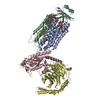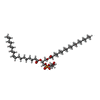+ Open data
Open data
- Basic information
Basic information
| Entry | Database: PDB / ID: 8yjp | |||||||||||||||||||||
|---|---|---|---|---|---|---|---|---|---|---|---|---|---|---|---|---|---|---|---|---|---|---|
| Title | Cryo-EM structure of human apo GPR156 | |||||||||||||||||||||
 Components Components | Probable G-protein coupled receptor 156 | |||||||||||||||||||||
 Keywords Keywords | MEMBRANE PROTEIN / GPCR / class C / GPR156 / cryo-EM / homodimer | |||||||||||||||||||||
| Function / homology |  Function and homology information Function and homology informationstereocilium bundle organization / G protein-coupled GABA receptor activity / G protein-coupled receptor heterodimeric complex / gamma-aminobutyric acid signaling pathway / plasma membrane Similarity search - Function | |||||||||||||||||||||
| Biological species |  Homo sapiens (human) Homo sapiens (human) | |||||||||||||||||||||
| Method | ELECTRON MICROSCOPY / single particle reconstruction / cryo EM / Resolution: 3.09 Å | |||||||||||||||||||||
 Authors Authors | Ma, X.Y. / Chen, L.N. / Liao, M.H. / Zhang, L.Y. / Xi, K. / Guo, J.M. | |||||||||||||||||||||
| Funding support |  China, 1items China, 1items
| |||||||||||||||||||||
 Citation Citation |  Journal: Nat Commun / Year: 2024 Journal: Nat Commun / Year: 2024Title: Molecular insights into the activation mechanism of GPR156 in maintaining auditory function. Authors: Xiangyu Ma / Li-Nan Chen / Menghui Liao / Liyan Zhang / Kun Xi / Jiamin Guo / Cangsong Shen / Dan-Dan Shen / Pengjun Cai / Qingya Shen / Jieyu Qi / Huibing Zhang / Shao-Kun Zang / Ying-Jun ...Authors: Xiangyu Ma / Li-Nan Chen / Menghui Liao / Liyan Zhang / Kun Xi / Jiamin Guo / Cangsong Shen / Dan-Dan Shen / Pengjun Cai / Qingya Shen / Jieyu Qi / Huibing Zhang / Shao-Kun Zang / Ying-Jun Dong / Luwei Miao / Jiao Qin / Su-Yu Ji / Yue Li / Jianfeng Liu / Chunyou Mao / Yan Zhang / Renjie Chai /  Abstract: The class C orphan G-protein-coupled receptor (GPCR) GPR156, which lacks the large extracellular region, plays a pivotal role in auditory function through G. Here, we firstly demonstrate that GPR156 ...The class C orphan G-protein-coupled receptor (GPCR) GPR156, which lacks the large extracellular region, plays a pivotal role in auditory function through G. Here, we firstly demonstrate that GPR156 with high constitutive activity is essential for maintaining auditory function, and further reveal the structural basis of the sustained role of GPR156. We present the cryo-EM structures of human apo GPR156 and the GPR156-G complex, unveiling a small extracellular region formed by extracellular loop 2 (ECL2) and the N-terminus. The GPR156 dimer in both apo state and G protein-coupled state adopt a transmembrane (TM)5/6-TM5/6 interface, indicating the high constitutive activity of GPR156 in the apo state. Furthermore, C-terminus in G-bound subunit of GPR156 plays a dual role in promoting G protein binding within G-bound subunit while preventing the G-free subunit from binding to additional G protein. Together, these results explain how GPR156 constitutive activity is maintained through dimerization and provide a mechanistic insight into the sustained role of GPR156 in maintaining auditory function. | |||||||||||||||||||||
| History |
|
- Structure visualization
Structure visualization
| Structure viewer | Molecule:  Molmil Molmil Jmol/JSmol Jmol/JSmol |
|---|
- Downloads & links
Downloads & links
- Download
Download
| PDBx/mmCIF format |  8yjp.cif.gz 8yjp.cif.gz | 121.2 KB | Display |  PDBx/mmCIF format PDBx/mmCIF format |
|---|---|---|---|---|
| PDB format |  pdb8yjp.ent.gz pdb8yjp.ent.gz | 94.3 KB | Display |  PDB format PDB format |
| PDBx/mmJSON format |  8yjp.json.gz 8yjp.json.gz | Tree view |  PDBx/mmJSON format PDBx/mmJSON format | |
| Others |  Other downloads Other downloads |
-Validation report
| Summary document |  8yjp_validation.pdf.gz 8yjp_validation.pdf.gz | 945.9 KB | Display |  wwPDB validaton report wwPDB validaton report |
|---|---|---|---|---|
| Full document |  8yjp_full_validation.pdf.gz 8yjp_full_validation.pdf.gz | 973.9 KB | Display | |
| Data in XML |  8yjp_validation.xml.gz 8yjp_validation.xml.gz | 19.8 KB | Display | |
| Data in CIF |  8yjp_validation.cif.gz 8yjp_validation.cif.gz | 26.8 KB | Display | |
| Arichive directory |  https://data.pdbj.org/pub/pdb/validation_reports/yj/8yjp https://data.pdbj.org/pub/pdb/validation_reports/yj/8yjp ftp://data.pdbj.org/pub/pdb/validation_reports/yj/8yjp ftp://data.pdbj.org/pub/pdb/validation_reports/yj/8yjp | HTTPS FTP |
-Related structure data
| Related structure data |  39345MC  8yk0C M: map data used to model this data C: citing same article ( |
|---|---|
| Similar structure data | Similarity search - Function & homology  F&H Search F&H Search |
- Links
Links
- Assembly
Assembly
| Deposited unit | 
|
|---|---|
| 1 |
|
- Components
Components
| #1: Protein | Mass: 38472.230 Da / Num. of mol.: 2 Source method: isolated from a genetically manipulated source Source: (gene. exp.)  Homo sapiens (human) / Gene: GPR156, GABABL, PGR28 / Production host: Homo sapiens (human) / Gene: GPR156, GABABL, PGR28 / Production host:  Homo sapiens (human) / References: UniProt: Q8NFN8 Homo sapiens (human) / References: UniProt: Q8NFN8#2: Chemical | ChemComp-MW9 / ( #3: Chemical | ChemComp-CLR / Has ligand of interest | N | Has protein modification | Y | |
|---|
-Experimental details
-Experiment
| Experiment | Method: ELECTRON MICROSCOPY |
|---|---|
| EM experiment | Aggregation state: PARTICLE / 3D reconstruction method: single particle reconstruction |
- Sample preparation
Sample preparation
| Component | Name: GPR156 / Type: ORGANELLE OR CELLULAR COMPONENT / Entity ID: #1 / Source: RECOMBINANT |
|---|---|
| Source (natural) | Organism:  Homo sapiens (human) Homo sapiens (human) |
| Source (recombinant) | Organism:  Homo sapiens (human) Homo sapiens (human) |
| Buffer solution | pH: 7.5 |
| Specimen | Embedding applied: NO / Shadowing applied: NO / Staining applied: NO / Vitrification applied: YES |
| Vitrification | Cryogen name: ETHANE |
- Electron microscopy imaging
Electron microscopy imaging
| Experimental equipment |  Model: Titan Krios / Image courtesy: FEI Company |
|---|---|
| Microscopy | Model: FEI TITAN KRIOS |
| Electron gun | Electron source:  FIELD EMISSION GUN / Accelerating voltage: 300 kV / Illumination mode: FLOOD BEAM FIELD EMISSION GUN / Accelerating voltage: 300 kV / Illumination mode: FLOOD BEAM |
| Electron lens | Mode: BRIGHT FIELD / Nominal defocus max: 1500 nm / Nominal defocus min: 700 nm / Cs: 2.7 mm |
| Specimen holder | Cryogen: NITROGEN / Specimen holder model: FEI TITAN KRIOS AUTOGRID HOLDER |
| Image recording | Electron dose: 52 e/Å2 / Film or detector model: FEI FALCON IV (4k x 4k) |
- Processing
Processing
| EM software | Name: PHENIX / Category: model refinement | ||||||||||||||||||||||||
|---|---|---|---|---|---|---|---|---|---|---|---|---|---|---|---|---|---|---|---|---|---|---|---|---|---|
| CTF correction | Type: PHASE FLIPPING AND AMPLITUDE CORRECTION | ||||||||||||||||||||||||
| 3D reconstruction | Resolution: 3.09 Å / Resolution method: FSC 0.143 CUT-OFF / Num. of particles: 164823 / Symmetry type: POINT | ||||||||||||||||||||||||
| Refine LS restraints |
|
 Movie
Movie Controller
Controller




 PDBj
PDBj









